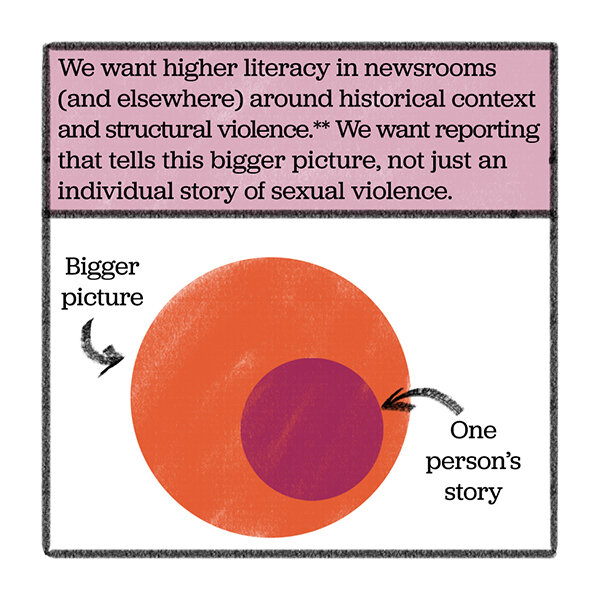Crowdsourced guidelines for journalists tackling the topic
Text and illustrations by Ellie Mejía
On September 12, we held our 118th Public Newsroom, “How Should We Cover Sexual Assault?” in trusty Build Coffee. That evening, our host was Jenny Casas, a WNYC radio reporter and former City Bureau fellow who has reported on political corruption, environmental racism and restorative justice, among other topics. Casas is currently collaborating with the Invisible Institute on its Citizens Police Data Project, focusing on complaints of sexual misconduct by Chicago police officers.
Her experience with this project prompted several questions: How can journalists report on sexual assault ethically, with respect for sources who are survivors of sexual violence? What would it look like to report on sexual violence in a way that is generative instead of extractive? What types of reporting on this topic are most useful to survivors and their networks of support?
This Public Newsroom gave us some space to brainstorm answers together. We rounded up a panel of experts, including Maritza Reyes, director of the sexual assault program at Mujeres Latinas en Acción, Lillian Cartwright, the director of education and training at Resilience, and Jim DeRogatis, who has reported on allegations of sexual abuse against R. Kelly since the early 2000s. Afterward, we turned the question to attendees: What changes would you like to see in the way news outlets cover sexual violence?
The following contributions were generated by attendees in small group discussions. Each illustration represents a different change, in the same vein as our Local News Contract campaign.
If you missed the newsroom and want to learn more, you can check out an audio recording of the panel, Casas’ slides, and our take-away sheet.
* More on victim-blaming
** Andrea Ritchie’s Invisible No More: Police Violence Against Black Women and Women of Color is a great example of reporting that digs deeper into a broader historical context.
*** On a harm reduction lens applied to journalism
**** More on shock value and on trauma porn
Support City Bureau’s work to reimagine local news by becoming a City Bureau Press Club member today.
To get twice-monthly emails including Chicago news and events, sign up for City Bureau’s Chicago newsletter.









